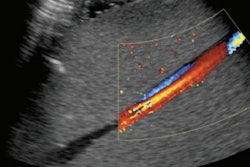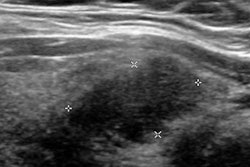
Using 3D ultrasound measurements of tumor volume rather than 2D measurements of diameter could be a better way to determine the aggressiveness of small papillary thyroid cancers (PTCs) -- and to guide active surveillance of tumors, according to an August 31 study in JAMA Otolaryngology -- Head and Neck Surgery.
In a study involving nearly 300 patients with papillary thyroid cancers, researchers from Memorial Sloan Kettering Cancer Center (MSKCC) in New York City found that 3D measurements of tumor volume identified tumor growth a median of 8.2 months before the tumor showed an increase in diameter. What's more, the tumors that grew in volume demonstrated a classic exponential growth pattern, with a median doubling time of 2.2 years, according to the authors.
"As the number of small, incidentally detected PTCs continues to increase, new approaches are needed to avoid overtreatment of tumors that would otherwise remain indolent and asymptomatic while identifying the small percentage of such tumors that will continue to grow," wrote the team led by Dr. Michael Tuttle. "Because PTCs appear to follow predictable growth kinetics under active surveillance, serial measurements of tumor volume hold significant promise in triaging patients to observation versus surgery."
Low-risk cancers
Thyroid cancer has been increasingly diagnosed in the U.S. and other countries due to more widespread use of imaging technologies. However, many of these cancers are small, low-risk, asymptomatic papillary thyroid cancers; up to 90% of these indolent cancers will never go on to cause symptoms or death, according to the group.
Recent research in Japan found that active surveillance is safe for PTCs smaller than 1 cm in diameter. Of the patients with these small PTCs, 10% to 15% experienced tumor growth, usually within five years. The threshold for surgical intervention was growth of 3 mm in diameter on 2D ultrasound -- the smallest difference that could be reliably measured with the modality, the authors noted.
However, the kinetics -- probability, rate, and magnitude -- of PTC growth during active surveillance haven't been well-defined, according to the MSKCC researchers.
"A more dynamic characterization of tumor growth based on 3D volume measurements may allow for earlier determination of whether a PTC is stable or growing," they wrote. "Such information would be of value in more precise tailoring of surveillance imaging and, if needed, intervention, in patients undergoing active surveillance."
Tumor growth kinetics
As a result, the researchers set out to describe the kinetics of papillary thyroid cancer growth in 291 patients at their institution who were receiving active surveillance with serial ultrasound exams for low-risk, intrathyroidal tumors 1.5 cm or smaller in size. The 291 patients had a mean age of 52 years; 219 (75.3%) were women and 72 (24.7%) were men.
Ultrasound exams were performed by radiologists every six months for two years, and then yearly after that. For the purposes of the study, an increase in tumor volume of more than 50% from baseline was judged to be a meaningful increase.
Over a median active surveillance period of 25 months (range, 6-166 months), only 11 (3.8%) of the 291 patients had tumor diameter growth of 3 mm or more. The cumulative incidence of this growth was 2.5% at two years of active surveillance and 12.1% at five years. There were no regional or distant metastases reported during active surveillance, according to the researchers.
For all 11 of these cases, 3D measurements of tumor volume on serial ultrasound studies identified growth before the tumor showed an increase in diameter -- at a median of 8.2 months sooner (range, 3-46 months). In addition, tumors that increased in volume showed a classic exponential growth pattern afterward, with a median doubling time of 2.2 years (range, 0.5-4.8 years). This indicates that growth can be accurately modeled, according to the researchers.
As a result, a meaningful increase in 3D tumor volume could potentially justify discontinuing active surveillance and proceeding to surgery. In addition, changes in 3D tumor volume over time could help in determining how often patients should receive surveillance imaging.
Delving further into the results, after performing multivariable analysis the researchers found that younger age at diagnosis was independently associated with the likelihood of more than 3 mm of tumor growth (hazard ratio per year, 0.92; p = 0.006); patients younger than 50 had a nearly fivefold likelihood of experiencing tumor growth within five years, compared with patients 50 and older (27.3% vs. 4.6%, p = 0.03). The patient's risk category at presentation was also independently associated with the likelihood of tumor growth (hazard ratio for inappropriate for observation, 55.17; p < 0.001).
Skilled radiologists are key
The researchers emphasized that the success of their institution's active surveillance management program depends on the availability of specialized and highly skilled radiologists. Before the patient is released from the suite, a senior radiologist reviews all images prepared by the sonographer and compares them with the patient's prior ultrasound images.
"This approach minimizes the expected variation between examiners and examinations, and also allows us to be confident that the serial 3D measurements used to calculate the tumor value fall within the ± 3-mm range of variation that we expected," they wrote. "With experience, expertise, and careful attention to detail, we are confident that these types of ultrasonographic examinations can be done outside of major medical centers."
Looking ahead, the group noted that additional studies will help determine the clinical significance of mild growth in PTC diameter and volume and further refine the thresholds for intervention.
Support for active surveillance
The study offers "invaluable and much-needed support" for implementing active surveillance protocols in the U.S., said Dr. Joseph Scharpf of the Cleveland Clinic Foundation in an invited commentary also published online August 31 in JAMA Otolaryngology -- Head & Neck Surgery.
"This study contributes to the body of knowledge regarding thyroid cancer, and the authors are to be commended for this excellent work that will benefit so many patients diagnosed with a cancer characterized as an epidemic of diagnosis rather than an epidemic of disease," Scharpf wrote. "The financial, physical, and emotional costs of thyroid cancer care associated with this increased incidence are significant and will continue to demand these careful and thoughtful approaches to care."




















